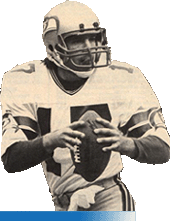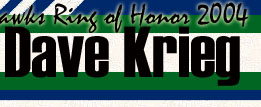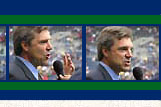|
Before the Seahawks media guides
were made available to correct any mispronunciations, a buzz about a “Dave
Kreeg” began circulating during the 1980 pre-season. Word was spreading
around the Puget Sound area that Dave Krieg (pronounced “Craig”) looked to be
a promising young passer for the Seahawks, with a knack for throwing the deep
ball.
At $25,000 per year with a $500.00 signing bonus, Krieg did well to drive his
Ford Pinto and survive his first years, symbolizing his status as an
undrafted free agent with only a dream and barely enough resources to get to
camp. Rumor has it that he even brought along the helmet from his alma mater,
the NCAA Div. III Independent Milton Wildcats.
The Zorn Days
Although Seattle had a respectable 9-7 season in 1979, fans were getting
uneasy about a team that had gone over-the-top with fake punts, field goals
and muffed passes to kickers. The gimmicks that characterized Seahawks
football raised eyebrows in a more sophisticated football city, basking in
the gold plated “Purple Haze” of success, discipline and tradition by Don
James and The University of Washington Athletic Department.
While local hero Jim Zorn was running for his life with little protection by
the O-line, his career was not taking on Fran Tarkenton qualities. As if
Commissioner Pete Rozelle’s promise to bring parity to the NFL were a
money-back guarantee, Dan Fouts became the standard against which pro
quarterbacks were measured by all expectations. Additionally, on the West
Coast, Joe Montana quickly advanced as the rising star of the early 1980s. In
the minds of local sportswriters and fans, Zorn was not measuring up.
The abysmal 4-12 1980 season included back-to-back nationally televised
embarrassments from a Monday Night debacle to a Thanksgiving Day disaster
against the Dallas Cowboys, which eventually pushed Jack Patera to the hot
seat. Seattle’s sparkling, silver bird of an NFL franchise had crashed and
burned like a 707 without a horizontal stabilizer.
Whether you call it intuition or desperation, Coach Patera benched Zorn and
started Krieg at the beginning of the 1982 season. It was an astounding decision
to some, but made sense considering Krieg’s first NFL start, on December 6th,
1981 when he showcased 20 of 26 passes for 264 yards with two TD's and a
rushing TD on the road in Denver.
Krieg’s run at the helm lasted only two weeks until the players' strike.
Before the walkout, Krieg was nursing an injured thumb. Before long, Patera
was fired. Interim Coach Mike McCormack went back to Zorn at the end of the
1982 season when the strike was over.
Uncertain of his future, Krieg patiently drove his Pinto back and forth to
the Kirkland facility, forming friendships with fellow players like Ron
Essink while working under the tutelage of Jim Zorn.
Before camp opened the following summer, new coach Chuck Knox, known for a
ball control offense, announced that he was opting to start Zorn. At face
value, this made sense for a couple of reasons. Zorn was considered to be one
of the best play-fake QBs in the NFL where play-action can sync very well
with a consistent running game. Also, Zorn’s range and style fit Knox’s
conservative playbook, since real estate on the run was the first objective
and passing, while important, came second. As a part of his approach, Knox
favored experience over youth, bringing in names like Harold Jackson, Charlie
Young, Reggie McKenzie and Blair Bush. Household names like Zorn and Largent
fit right into Knox’s plan. Knox was an offensive line coach at heart, so for
once, Zorn would finally get the protection he needed to play his best game.
Deep down, Dave Krieg had other aspirations. "I knew I had to deliver a
knockout blow to dislodge the champ", Krieg once intimated, regarding
his hopes of replacing Zorn as the starter one day.
Statistically, Zorn was not featured in the Seahawk offense for the first 8
games of the season. The focus was on running back Curt Warner. Additionally,
Tom Catlin’s ball-hawking defense factored into most of the success early in
the Knox era, where in the first half of the 1983 season, the Hawks were
winning only half of their games and that, mostly by turnovers.
From day one, Knox preached a modified message of Vince Lombardi’s: in a game
of inches, a team needs to find that little, minute difference that enables a
team to move from the status of “the have-nots to becoming one of the haves.”
In games where the QB’s ability to bring a team from behind was the critical
factor (in other words, where “Ground Chuck” was not enough offense to play
catch-up football) Zorn was having difficulty rallying the troops to produce.
His diminished passing ability began to uncover a reality with which several
players on the team were already familiar.
Rolling out and circling back and forth to get a pass off had proven to put
Zorn in peril too often. More than his share of sacks to the point of injury
had eventually altered his skills and abilities as a pro passer. Throwing
from the pocket sounds great in theory, but years of pocketless offense
simply took its toll. One can only wonder what Zorn’s career would have been
like had the offensive line been disciplined and developed under Knox’s
system from day one.
The New QB
On October 23, 1983 a Kingdome crowd of 61,615, normally roaring like thunder
and engulfed in waves, sat stunned as the Pittsburgh Steelers led the
Seahawks 24-0 at halftime. Zorn had thrown eight passes and completed one,
for two yards, and had two interceptions. Chuck Knox was still looking for
the single factor that pushed his Seahawks to the level of competing
head-to-head with the Chuck Nolls and the Steelers of the NFL.
After halftime, Dave Krieg trotted onto the field and immediately clicked
with the offense. Coach Chuck Knox had made a decision that became known to
be “the turning point” of the “Cinderella Season,” hoping to "get
something going". And get something going he did. While watching this
game on national television in the Midwest, this writer recalls that it was
as if the Seahawk offensive line deliberately allowed the Steelers to maul
Jim Zorn during the first half, only to give Dave Krieg sublime protection
during the second half. Whether it was conspiratorial or not, Dave Krieg
inspired his team, as he proceeded to throw touchdown passes to Steve Largent
and Paul Johns.
In the ensuing defensive series, Manu Tuiasosopo hit Franco Harris to force a
fumble that was snapped-up by Kenny Easley at the Steelers’ 11 yard line. On
the next play, Krieg was forced out of the pocket and he scrambled for 11
yards for an apparent touchdown. A holding penalty took the score away and
gave Seattle a first and 20 from the 21. On the very next play, Krieg hit
Largent for the third touchdown. With 1:49 left to play, Krieg and the
Seahawks had the ball on their own 30. A 28 yard march downfield came up
short at the Pittsburgh 42 as Krieg’s fourth-down passing attempt was
deflected by the Steelers Dwyane Woodruff.
It became the loss that was in reality the “win” for the Seahawks.
Knox said to Krieg, “the job is yours until you lose it.” Finally, Krieg had
delivered the “knockout blow to dislodge the champ.” In sportsman-like
fashion, Zorn gave his public endorsement of Krieg, emphasizing number 17’s
good vision downfield, his strong arm and his ability to improvise and rally
the team.
While competitors by position, it is well known that Jim Zorn and Dave Krieg
maintained a close, cordial relationship through their time as Seahawk QBs,
reflecting a sense of unity in the locker room that became infectious to the
entire team. That relationship of mutual respect between Zorn and Krieg
continues to this very day.
It is no wonder that Zorn, after facing his share of criticism by the press
and fans, would be vindicated by multiple honors. As the team’s quarterbacks
coach today, he continues to shape the destiny and future of the Seahawks on
a variety of levels.
Krieg eventually led Seattle to a 5-3 record for the last half of the season.
With only 8 NFL starts, Krieg's totals for the 1983 season (147 passes
completed of 243 attempts, for 2,139 yards, 18 touchdowns and 11
interceptions) were more typically seen in players with far greater
experience, finishing the season as the NFL’s fourth-rated passer. Krieg led
Seattle to defeat the New England Patriots in the last game of the 1983
season en route to their first playoff berth ever.
In that very first playoff game, Seattle hosted the Denver Broncos at home on
Christmas Eve. Victoriously at the end of the game, Pete Gross announced
Seattle’s first playoff victory over the radio, “you can pack your bags for
Miami, it is all over here.” As the Seahawks man-handled the Broncos, Krieg
utilized several receivers in that game, passing right through the coverage
of famed Denver defensive back Louis Wright. Some say that it was one of the
most poised performances Krieg ever put up in the Kingdome.
One of Krieg’s moments of resiliency came to life in the next playoff game in
Miami after he threw an untimely interception in the 4th quarter to put the
game momentum back into the hands of Dan Marino’s Dolphins. Krieg had been
connecting with Paul Johns all day as Largent was covered by a zone defense
that prevented a completion between the two. Suddenly, the Dolphins went to a
man-to-man defense which (to the surprise and delight of Krieg) gave him an
opening to make a midfield completion to Largent. That completion eventually
set up Curt Warner for a risky, but effective sweep to the end zone for the
win.
The bench ran onto the the field at that win in celebration and the
Nordstroms, who were deliberately incognito for much of Knox’s charge, were
seen victorious on the sidelines with unprecedented jubilation.
By the next day, the unknown Dave Krieg had become a national celebrity as he
was interviewed by Len Berman via KING TV5 during an NBC nationally televised
halftime. Krieg acknowledged that the win (now logged-in as the “Miracle over
Miami”) had more to do with “character on [his] team’s part” than any single
stand-out performer.
Going on to face the Raiders in Los Angeles in one last game away from the
Super Bowl very likely epitomized Krieg’s accomplishments and limitations on
a single occasion. The eventual Super Bowl Champion Raiders came-on hard and
heavy after Krieg, hammering him in play after play. They hit Seattle’s
offense with schemes that exceeded the Seahawks’ preparation and poise. Krieg
had his first major let down, both in mechanics and confidence. It is a
rite-of-passage that every aspiring NFL quarterback must face, but very few
face this challenge at the conference championship level.
The Revenge
Season
During that off-season, the Seahawks courted Warren Moon heavily, offering
him what was rumored to be a blank check (reportedly over $1 million, very
high by 1984 standards). However, Moon signed with Houston while Krieg was
forced to step-up with far more than expected of him, due to the
season-ending injury of Curt Warner at the outset of the ’84 campaign.
Krieg had re-negotiated his contract and soon traded his old worn-out Ford
Pinto for a BMW. Transitions between a Pinto and the BMW appropriately
symbolized the advance of his career that year. The ’84 Seahawks became the
defensive machine that took the AFC by storm. Assistants Tom Catlin (defense)
and Rusty Tillman (special teams) redefined the industry standards on
creating opportunities in other aspects of the game besides offense. Krieg
managed 3,671 in passing yards with 32 TDs. The result was an unforgettable
12 and 4 season, the Seahawks best ever.
A revenge playoff match in the Kingdome against the Raiders set the stage for
Krieg to hit Daryl Turner in the end zone for the winning score after a
defensive battle. It was to be the last playoff game Seattle would ever win
to date. After the 1984 season, Krieg was elected to his first Pro Bowl.
Over time and exposure to persistent high pressure, however, Krieg unfurled
some of his weaknesses (fumbles, interceptions and miscues) as fans began to
debate his consistency. After an up and down 1985 season and a four game
meltdown during the middle of the 1986 season, columnists and critics alike
began describing Krieg as a “Jekyll and Hyde” player with hostile comments
coming from the fans, including boos in the Dome.
Whereas Zorn was under pressure in his day to live up to the greatness of a
Dan Fouts, before long, Krieg’s performances were measured against the likes
of John Elway. Eventually, Chuck Knox found himself in a situation with Krieg
reminiscent of the Jim Zorn scenario. Before long, however, the differences
would be obvious.
At a press conference Knox announced that Gale Gilbert would take over the
starting quarterback position from Dave Krieg. This move was not a great
shock, but became a definitive point for Krieg’s future where becoming
Seattle’s “franchise QB” so-to-speak, never materialized quite the way many
had hoped.
The inexperienced Gale Gilbert did little to help the Hawks, however, as they
fell to the New York Jets in the Kingdome, 38-7. Ironically it was the Jets
who, by winning the last game of their season, edged a solid Seattle team out
of the playoffs. Pulling Dave Krieg from the line-up proved to be more costly
than the Seahawks might have imagined.
Returning to the starting role for the remainder of 1986, Krieg responded by
leading the Hawks to a 5-game winning streak and one of the most memorable
finishes at 10 and 6, including a defeat of the Dallas Cowboys on
Thanksgiving Day.
The Pinnacle Year
It was the 1988 season that became a pinnacle year for Krieg, even though he
was only able to play about half of the games. His first game of the season
was nearly over-shadowed by the antics of Brian Bosworth in Denver. In that
outing, Krieg was only 4 of 13 in the first-half. As was often the case
throughout his career, Krieg’s resiliency won out as he threw for two
touchdowns in the third quarter to lead the Seahawks to a 21-14
season-opening victory over the Broncos.
“Mudbone,” as his lineman were fond of calling him, was hit very hard in San
Diego that season, separating his shoulder and lowering the boom on hopes for
an outstanding season for Krieg and the Hawks. After seven weeks in rehab and
out of play, Krieg returned (11/13/88) to put together a fight to the finish
against Warren Moon’s Houston Oilers. After comparable play by both
quarterbacks, Krieg helped cap off the game off with a 10-play drive. This
set up Norm Johnson’s game-winning field goal with less than one second to go
for a 27-24 victory.
In that 1988 season, Krieg led the NFL in touchdown efficiency and was named
AFC player-of-the-week after leading the Seahawks past the Raiders for the
division title. In that game, (12-8-88) Krieg passed for 410 yards and four
touchdowns. He finished that season with a fourth quarter rally against the
Cincinatti Bengals in the playoffs, despite the post-season loss, and was
elected to his second Pro Bowl with a QB rating of 94.6 -- second in the NFL.
Conclusion
Among many unsurpassed accomplishments by Dave Krieg, few may be more
important than his directing the team as quarterback to the only
three playoff victories in Seahawks history – defeating the Broncos and Dolphins after the '83
season and eliminating the defending champion Raiders after the '84 season.
A three time pro bowler, Dave
Krieg stands in the NFL record books ranked 11th all time in
passing yardage and 9th in total touchdowns.
Virtually unnoticed, a Ford Pinto showed up at Seahawks camp one day in the
early 80s. A very classy BMW drove away in 1992. Just like that finely
engineered, classic motor car, its passenger, number 17, Dave Krieg, will
remain to be one of the most legendary performers ever to be on display in
any Seahawks showroom.
Thanks for the memories, Dave - you are cherished by your fans and we will
never forget you!
Don Christensen, a native of the Seattle area is a freelance writer on sports topics. You
can reach him at audioeffects@yahoo.com.
|





